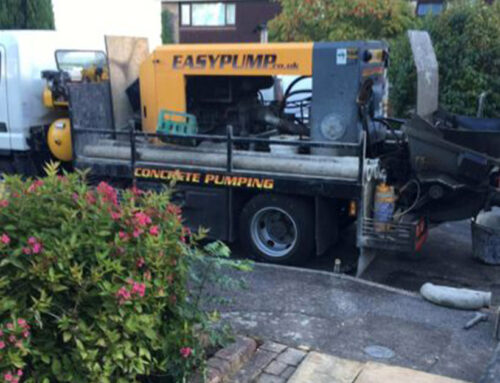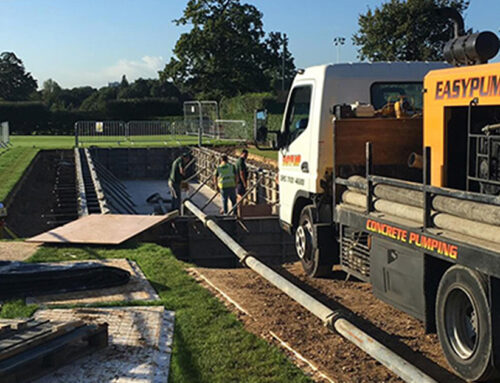When you’re starting a construction project, choosing the right concrete pump is key vital to a smooth, cost-effective build. There are two main types to consider: concrete boom pumps and line pumps. This post will explain what they are, their benefits, and when to use each one, helping you decide the best pump for your project.
Understanding Concrete Boom Pumps
A concrete boom pump has a long, flexible arm (the boom) mounted on a truck, perfect for quickly moving large amounts of concrete to high or far places. This makes boom pumps great for big construction jobs.
Advantages of Concrete Boom Pumps
- High Efficiency: Concrete boom pumps are capable of pumping concrete at high volumes, which significantly cuts down the time required for concrete placement. These make them highly efficient, especially for large-scale projects where time is of the essence.
- Extended Reach: The key feature of a boom pump is its extendable boom arm that can reach high and distant locations. This ability allows for the delivery of concrete to high-rise sites or areas that are difficult to access, removing the need for additional lifting equipment such as cranes or buckets.
- Precision: The manoeuvrability of the boom arm enables precise placement of concrete. This precision helps in reducing reduce material waste and enhances the quality of the construction work, as concrete can be placed exactly where it’s needed, even in complex or constrained environments.
Understanding Concrete Line Pumps
Line pumps are smaller and more compact compared to boom pumps, utilising flexible hoses to transport concrete. They are typically favoured for smaller construction projects or in scenarios where space is limited, and larger equipment like boom pumps cannot be accommodated. Line pumps are ideal for sites with access challenges, as their hoses can be extended to reach areas that are difficult to access with larger machinery.
Advantages of Concrete Line Pumps
- Cost-Effectiveness: Line pumps are a more economical choice, particularly for smaller projects. Their operational and rental costs are generally lower than those of boom pumps, making them a budget-friendly option.
- Versatility: These pumps excel in environments where space is limited or the layout is complex. with limited space or complex layout. Their ability to navigate tight spaces and adapt to various project demands makes them a flexible solution where a boom pump would be impractical.
- Ease of Setup: Due to their compact size, line pumps require less space for setup, which is a significant advantage on urban or crowded job sites. This ease of setup not only saves time but also makes line pumps an ideal choice for projects in densely populated areas or sites with limited access.
Related articles: Concrete Pumps: A Facility Your Construction Requires
Which Concrete Pump Should You Choose?
Consider Your Project’s Scale and Complexity
- Boom Pumps: These are most suitable for large-scale projects, such as commercial buildings, bridges, or high-rise constructions. Their capacity to pump large volumes of concrete quickly and to great heights or distances makes them ideal for expansive and complex projects.
- Line Pumps: These pumps are better suited for smaller, more detailed tasks. If your project involves residential slabs, sidewalks, or small foundations, a line pump offers the precision and accessibility needed for such work, along with being more cost-effective for these smaller scales.
Assess the Job Site’s Accessibility
- Boom Pumps: These pumps need a lot of space to operate effectively. They are most suitable for locations where the site is spacious enough to accommodate their larger size. If your job site has ample room for manoeuvring and setting up the pump, then a boom pump would be a good fit.
- Line Pumps: These are ideal for job sites with limited access or where space is restricted. restricted space. They can easily navigate through narrow passages and are well-suited for environments that are constrained or densely populated. If your project site is crowded or has tight access points, a line pump would be more appropriate.
Evaluate the Concrete Placement Needs
- Boom Pumps: These are equipped to pump concrete rapidly and in large volumes, making them ideal for projects where quick and efficient concrete placement is necessary. If your project requires fast filling of large areas or you need to cover extensive distances, boom pumps provide the speed and capacity to get the job done efficiently.
- Line Pumps: On the other hand, offer a more controlled and slower pouring process, which is perfect for intricate or detailed concrete work. If your project demands precision in the concrete placement, with specific flows or in detailed patterns, a line pump allows for the meticulous handling needed in such situations.
Additional resources: Concrete Pump Hire: Everything You Need to Know
Conclusion
Choosing between a concrete boom pump and a line pump depends on your project’s size, site access, and concrete placement needs. Boom pumps are ideal for large, complex projects, offering high power and reach for efficient work. Line pumps, on the other hand, are perfect for smaller projects or restricted areas, offering flexibility and cost benefits. Knowing each pump’s strengths and limitations helps you make an informed decision, leading to the success of your construction endeavour.
To make the best decision for your construction needs, consider these factors carefully and match them with your project requirements. This way, you can optimise your construction process, ensuring efficiency and effectiveness in achieving your project goals.
Ready to choose the perfect concrete pump for your project? Visit Easypump now to explore our extensive range of boom and line pumps tailored to meet every construction challenge.
Contact us today to get expert advice and ensure your next project is a success with the right concrete pumping solutions!
FAQs:
1. What is the main difference between a concrete boom pump and a line pump?
The main difference lies in their design and application. A concrete boom pump is truck-mounted with a large, extendable boom arm for reaching high or distant areas, ideal for large-scale projects. In contrast, a line pump is smaller and pumps concrete through hoses laid on the ground, suitable for smaller projects or areas with limited access.
2. When should I use a concrete boom pump?
Use a concrete boom pump for large construction projects, such as high-rise buildings or when you need to pump concrete over large distances or obstacles. It’s ideal for projects requiring fast, high-volume concrete placement.
3. What are the benefits of using a line pump?
Line pumps are more versatile and manoeuvrable, making them perfect for smaller projects, indoor areas, or sites with restricted access. They are also more cost-effective for smaller volumes of concrete.
4. Can a line pump handle the same types of concrete as a boom pump?
Yes, line pumps can handle a wide variety of concrete mixes, similar to boom pumps. However, the capacity and pumping speed may vary, so it’s crucial to match the pump type with the project requirements.
5. Is there a significant cost difference between renting a boom pump and a line pump?
Yes, generally, renting a boom pump is more expensive due to its larger size, greater reach, and higher output capabilities. Line pumps are more budget-friendly, especially for smaller projects or those with less demanding concrete placement needs.
6. How do I determine which pump is more suitable for my construction project?
Consider the project size, the volume of concrete needed, access to the site, and your budget. For large-scale projects with ample space and significant concrete volume, a boom pump is more suitable. For smaller projects, tight spaces, or when budget constraints are a priority, a line pump would be the better choice. Consulting with a concrete pumping expert can also help you make an informed decision.


